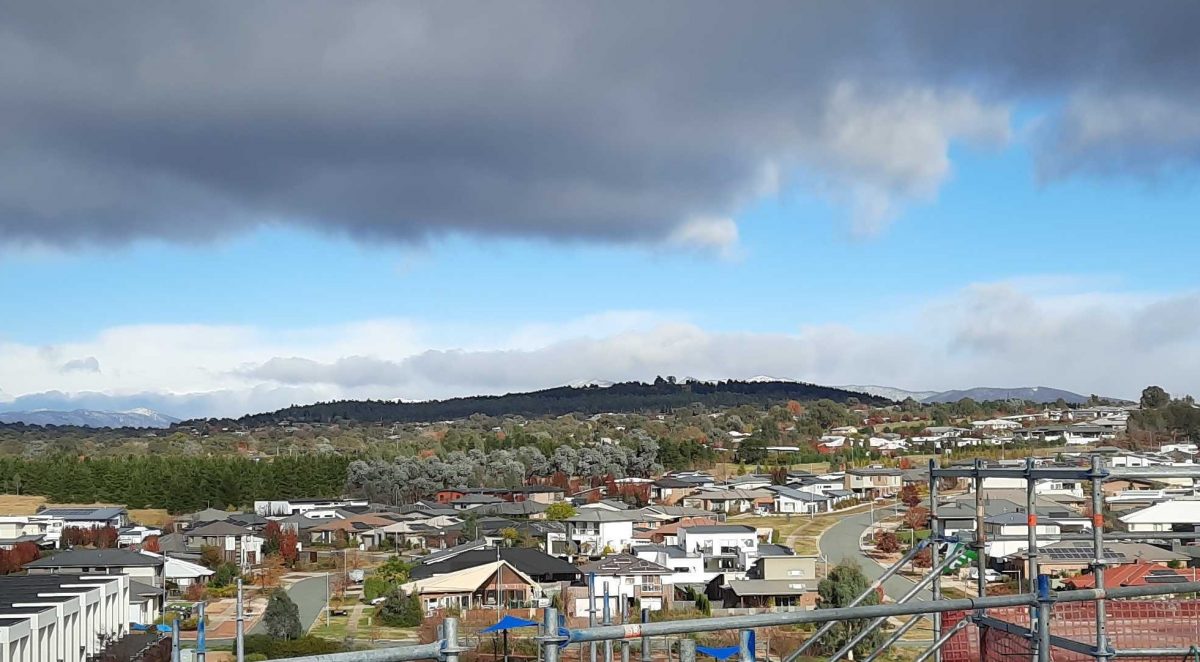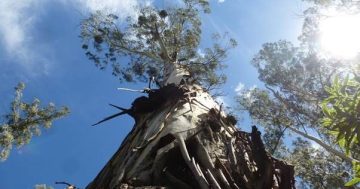
The suburb of Wright will struggle to reach a little more than half the tree canopy target. Photo: Ian Bushnell.
The ACT’s 30 per cent tree canopy target is too small, but despite this, some new suburbs will struggle to reach it without changes to proposed legislation and planning rules, according to the peak architecture body.
The ACT chapter of the Australian Institute of Architects says in its submission on the draft Urban Forest Bill, which aims to protect Canberra’s trees, that tree cover should be equal across the ACT, but there did not seem to be a clear plan for retrofitting appropriate tree infrastructure in newer areas.
The Institute says the target of 30 per cent canopy cover by 2045 is comparatively modest, pointing to Melbourne and Ballarat, which are aiming for 40 per cent by 2040, and Hobart for 40 per cent by 2046.
It says the Alastair Swayn Internship Research Project found that in the Molonglo Valley suburb of Wright, 30 per cent would not be possible and that the nature of newer suburbs, with their smaller section width, smaller block size and the significant amount of space dedicated to roads/driveways, meant that there wasn’t enough space available to plant the number of trees required to hit the target.
Wright would struggle to reach 19 per cent, and even if Variation 369 had been in place, the suburb would only just clear the target at 32 per cent, a figure inflated by trees in parks/surrounding nature reserves, which boost canopy cover numbers but provide little cooling benefit to occupants or dwellings.
The 30 per cent figure may not be achievable in other suburbs that do not have the benefit of a significant public urban forest, the study says.
The Institute is calling for the recently approved Variation 369, which is meant to ensure residential blocks have sufficient trees and open space, and the Urban Forest Bill to be integrated and simplified to define a Green Plot Ratio.
“This would be a more inclusive approach considering all vegetation and soils as part of the urban forest and the importance of biodiversity rather than just focusing on individual trees as indicated by the strategy,” the submission says.
The Bill should include measures to retrofit recently developed areas with little or no tree canopy, and there should be greater coordination with ACT government agencies to improve tree canopy on residential streets and public land.
The submission also says that Variation 369 and the Urban Forest Bill need to align with the coming planning reforms to minimise hard surfaces for car parking, driveways and turning circles.
“The success of our urban forest is linked to our ability to reduce driveway hardstand on private blocks,” the Institute says.
This could be achieved through parking forward of the building line to enable shorter driveways, shared driveway and street parking options allowing parking to bedroom ratios to be relaxed if parking demand is reduced by alternative transport modes and work-at-home strategies, and relaxing the requirement for a minimum of one covered car space.
To help prioritise land use for soft landscaping and trees, the Institute says the government should focus on balancing building plot ratios with green plot ratios, including site coverage, for trees; creating incentives for smaller dwellings with provision for dual occupancy and secondary residence unit titling; and replacing the capped number of housing storeys with building envelope controls, along with an allowance for attics and basements.
The Institute also says the growing size of Canberra’s houses needs to be addressed.
“Canberra needs housing that is affordable, sustainable, and of high amenity that is achieved through clever design strategies, including smaller, energy-efficient, low carbon dwellings; cost-effective, space-efficient and quality-controlled mass housing; and the adaptation of existing housing stock to accommodate multi-generational
families, and support ageing-in-place,” it says.
It added that the legislation may also have unintended consequences, such as property owners, including the government, not planting trees because of fears that they would prevent future development or expansion.
Protecting such a large number of trees in older areas like the inner south could also limit the transition to a more compact city.
The Institute warns that the legislation does not define a replacement tree size which may lead to inappropriate species of different sizes being planted.
It wants to see tree quota or canopy quota (minimum/maximum) tied to block size to help ensure equity across Canberra.
“Existing blocks that have many more trees and canopy (than the 30 per cent) should not be penalised for contributing more to our urban forest,” the Institute says.
Submissions for the Draft Urban Forest Bill closed on 2 June.
Original Article published by Ian Bushnell on Riotact.





